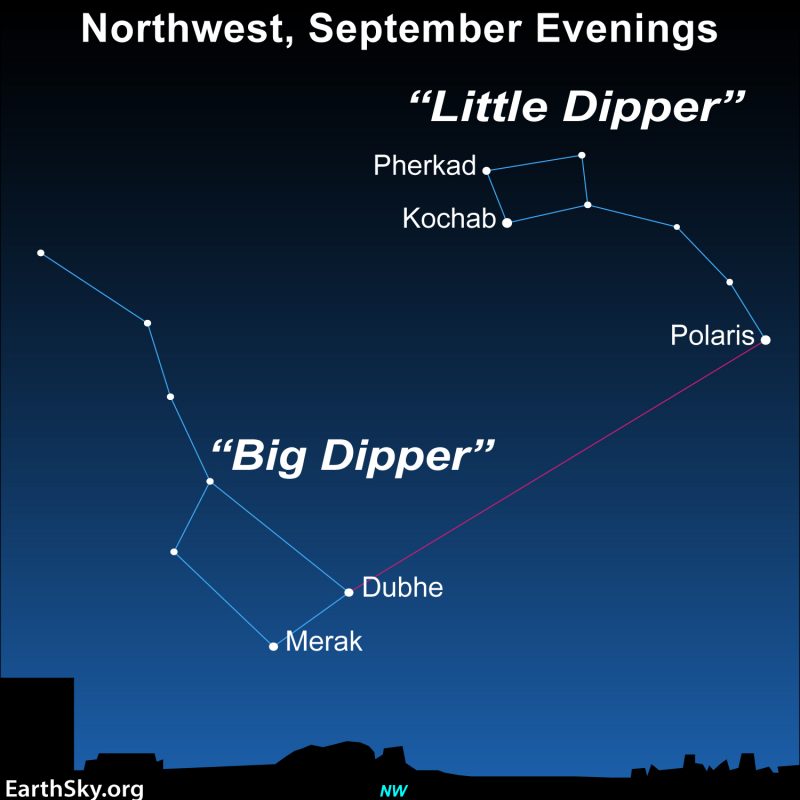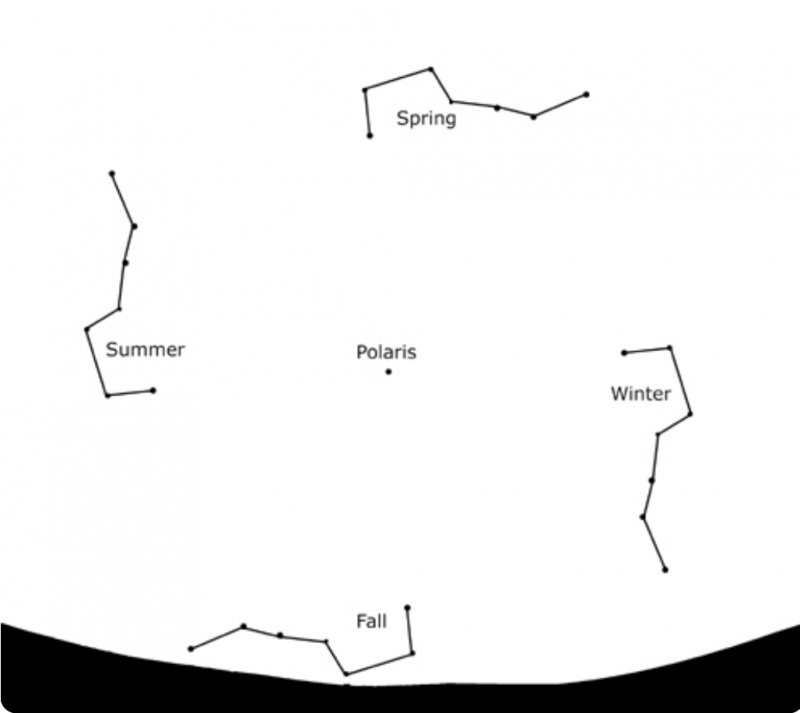
Use Big Dipper to find Polaris
The northern sky is like a large celestial clock, with Polaris – aka the North Star – at its center. In other words, the entire northern sky wheels in a great circle throughout the night (although it’s wheeling in a counter-clockwise direction). But the northern star Polaris stays still (or nearly so). That’s because Earth’s northern axis nearly points to it. And so Polaris is the famous North Star, used by sea navigators and scouts to find the direction north. Want to find it? You can use the famous Big Dipper asterism to locate Polaris.
Notice that a line from the 2 outermost stars in the bowl of the Big Dipper points to Polaris. And notice that Polaris marks the tip of the handle of the Little Dipper. Just notice all this soon, because, in September, the Big Dipper is headed for its least noticeable time of year. The reason is that the Big Dipper swings full circle – 360 degrees – around Polaris in about 23 hours and 56 minutes. In 24 hours, the Big Dipper actually swings more than a full circle, or 361 degrees. Does that make a difference? Yes! It means that – if you look at the same time each evening – the Big Dipper will appear just a little bit lower in the northwestern evening sky.
In other words, the Dipper is descending in the northwestern evening sky, from one night to the next. And that means that, a month from now at mid-evening (say around early October) the Big Dipper will be noticeably lower in the northwest. For some months in autumn, the Big Dipper is beneath the horizon in the evening, as seen from southernmost latitudes in the United States. That might be why, if you’re just learning the sky, you sometimes look for the Dipper and can’t find it.
Meanwhile, the Big Dipper is circumpolar, or always above the northern horizon, from more northerly latitudes. You’ll find it in your sky throughout the year as seen from the northern U.S., Canada and similar latitudes.
The Dipper throughout time
The constant motion from night to night of these stars circling Polaris is a bit like a bear circling its prey, looking for a way to attack. Several ancient cultures from the Greeks and Romans to the Mi’kmaq Indians likened these stars to a bear.
In Greek mythology, the Big Dipper asterism represents the hindquarters and tail of the constellation Ursa Major, the Great Bear. The Mi’kmaq saw the three stars of the Big Dipper handle as hunters chasing the bear.
Watch the Big and Little Dippers circle around Polaris tonight!

Bottom line: To locate Polaris, the North Star, just draw a line between the two outer stars in the bowl of the Big Dipper.
The Big and Little Dippers: All you need to know
EarthSky astronomy kits are perfect for beginners. Order today from the EarthSky store
Enjoying EarthSky so far? Sign up for our free daily newsletter today!
The post Use Big Dipper to find Polaris in September first appeared on EarthSky.
from EarthSky https://ift.tt/3t5iFxC

Use Big Dipper to find Polaris
The northern sky is like a large celestial clock, with Polaris – aka the North Star – at its center. In other words, the entire northern sky wheels in a great circle throughout the night (although it’s wheeling in a counter-clockwise direction). But the northern star Polaris stays still (or nearly so). That’s because Earth’s northern axis nearly points to it. And so Polaris is the famous North Star, used by sea navigators and scouts to find the direction north. Want to find it? You can use the famous Big Dipper asterism to locate Polaris.
Notice that a line from the 2 outermost stars in the bowl of the Big Dipper points to Polaris. And notice that Polaris marks the tip of the handle of the Little Dipper. Just notice all this soon, because, in September, the Big Dipper is headed for its least noticeable time of year. The reason is that the Big Dipper swings full circle – 360 degrees – around Polaris in about 23 hours and 56 minutes. In 24 hours, the Big Dipper actually swings more than a full circle, or 361 degrees. Does that make a difference? Yes! It means that – if you look at the same time each evening – the Big Dipper will appear just a little bit lower in the northwestern evening sky.
In other words, the Dipper is descending in the northwestern evening sky, from one night to the next. And that means that, a month from now at mid-evening (say around early October) the Big Dipper will be noticeably lower in the northwest. For some months in autumn, the Big Dipper is beneath the horizon in the evening, as seen from southernmost latitudes in the United States. That might be why, if you’re just learning the sky, you sometimes look for the Dipper and can’t find it.
Meanwhile, the Big Dipper is circumpolar, or always above the northern horizon, from more northerly latitudes. You’ll find it in your sky throughout the year as seen from the northern U.S., Canada and similar latitudes.
The Dipper throughout time
The constant motion from night to night of these stars circling Polaris is a bit like a bear circling its prey, looking for a way to attack. Several ancient cultures from the Greeks and Romans to the Mi’kmaq Indians likened these stars to a bear.
In Greek mythology, the Big Dipper asterism represents the hindquarters and tail of the constellation Ursa Major, the Great Bear. The Mi’kmaq saw the three stars of the Big Dipper handle as hunters chasing the bear.
Watch the Big and Little Dippers circle around Polaris tonight!

Bottom line: To locate Polaris, the North Star, just draw a line between the two outer stars in the bowl of the Big Dipper.
The Big and Little Dippers: All you need to know
EarthSky astronomy kits are perfect for beginners. Order today from the EarthSky store
Enjoying EarthSky so far? Sign up for our free daily newsletter today!
The post Use Big Dipper to find Polaris in September first appeared on EarthSky.
from EarthSky https://ift.tt/3t5iFxC

Aucun commentaire:
Enregistrer un commentaire